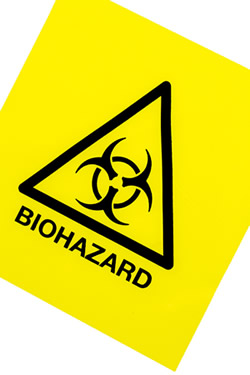Biohazard waste is dangerous. Know the facts
Biohazard waste is dangerous. Know the facts
Tons of biohazard waste is discarded each year from every medical facility. From used needles to soiled linens, all of these items must be handled with care from the moment that they become contaminated. Biohazard containers make disposal easy for caregivers, but accidents happen in almost every facility. Biohazard items are dangerous, and you should know the facts surrounding their use.
Airborne Pathogens Present in Biohazard Waste
In most cases, people are concerned about liquid or solid contaminants inside of biohazard containers. They can be absorbed into the skin or through cuts as well. However, there should be more concern about airborne pathogens. If biohazard waste is improperly handled or stored, these pathogens can enter the facility’s air mass. With air conditioning running in most buildings, the pathogens spread very quickly. As a result, disease can be spread by just breathing in the germs. This type of waste spread is entirely dangerous because the airborne pathogens aren’t visible to the naked eye.
Discarded Vaccines Pose Risks
A caregiver offers a vaccine to a patient, and the needle and vial are immediately discarded into biohazard containers. If these items are left outside of the container, however, disease can still be spread. Many vaccines are derived from an active form of a disease, such as mumps or measles. Although vaccines are safe when they’re injected into the body, they can actually be dangerous when they’re not properly discarded. At that point, the vaccine can spread the disease that it’s trying to protect people from in the first place.
Needle Pricks are Common
Nurses, doctors and other medical personnel work around needles all day long. Although a person might be entirely competent at their job, needle pricks afflict thousands of people each year. These needles can be contaminated with nearly any disease, including serious types. Every medical worker should be extra cautious around the back office. A needle that’s left uncapped and on a table can easily prick a person. Each worker needs to be diligent about capping and discarding the needle after each use. Careful waste management can reduce pricks in the industry.
Ideally, every medical facility should have a refresher course on how to handle biohazard waste. A quarterly class on basic themes and any updates is valuable for every worker. When waste disposal is taken seriously, everyone can be safe from any diseases and other contaminants. Both caregivers and patients benefit from more knowledge on the subject.









